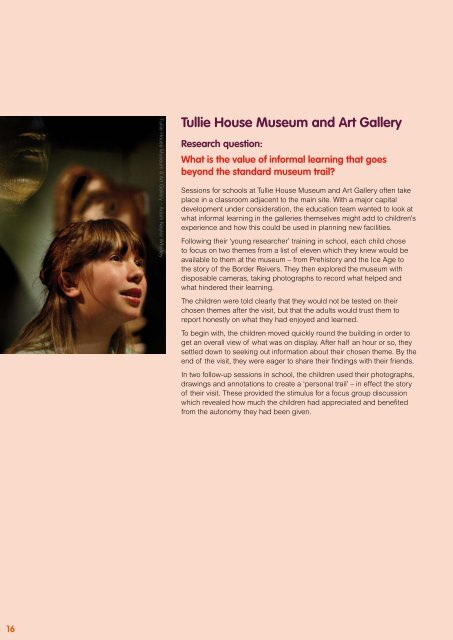Children-as-Co-researchers-in-the-design-of-museum-and-gallery-learning
Children-as-Co-researchers-in-the-design-of-museum-and-gallery-learning
Children-as-Co-researchers-in-the-design-of-museum-and-gallery-learning
Create successful ePaper yourself
Turn your PDF publications into a flip-book with our unique Google optimized e-Paper software.
Tullie House Museum & Art Gallery – Adam Naylor Whalley<br />
Tullie House Museum <strong>and</strong> Art Gallery<br />
Research question:<br />
What is <strong>the</strong> value <strong>of</strong> <strong>in</strong>formal learn<strong>in</strong>g that goes<br />
beyond <strong>the</strong> st<strong>and</strong>ard <strong>museum</strong> trail?<br />
Sessions for schools at Tullie House Museum <strong>and</strong> Art Gallery <strong>of</strong>ten take<br />
place <strong>in</strong> a cl<strong>as</strong>sroom adjacent to <strong>the</strong> ma<strong>in</strong> site. With a major capital<br />
development under consideration, <strong>the</strong> education team wanted to look at<br />
what <strong>in</strong>formal learn<strong>in</strong>g <strong>in</strong> <strong>the</strong> galleries <strong>the</strong>mselves might add to children’s<br />
experience <strong>and</strong> how this could be used <strong>in</strong> plann<strong>in</strong>g new facilities.<br />
Follow<strong>in</strong>g <strong>the</strong>ir ‘young researcher’ tra<strong>in</strong><strong>in</strong>g <strong>in</strong> school, each child chose<br />
to focus on two <strong>the</strong>mes from a list <strong>of</strong> eleven which <strong>the</strong>y knew would be<br />
available to <strong>the</strong>m at <strong>the</strong> <strong>museum</strong> – from Prehistory <strong>and</strong> <strong>the</strong> Ice Age to<br />
<strong>the</strong> story <strong>of</strong> <strong>the</strong> Border Reivers. They <strong>the</strong>n explored <strong>the</strong> <strong>museum</strong> with<br />
disposable camer<strong>as</strong>, tak<strong>in</strong>g photographs to record what helped <strong>and</strong><br />
what h<strong>in</strong>dered <strong>the</strong>ir learn<strong>in</strong>g.<br />
The children were told clearly that <strong>the</strong>y would not be tested on <strong>the</strong>ir<br />
chosen <strong>the</strong>mes after <strong>the</strong> visit, but that <strong>the</strong> adults would trust <strong>the</strong>m to<br />
report honestly on what <strong>the</strong>y had enjoyed <strong>and</strong> learned.<br />
To beg<strong>in</strong> with, <strong>the</strong> children moved quickly round <strong>the</strong> build<strong>in</strong>g <strong>in</strong> order to<br />
get an overall view <strong>of</strong> what w<strong>as</strong> on display. After half an hour or so, <strong>the</strong>y<br />
settled down to seek<strong>in</strong>g out <strong>in</strong>formation about <strong>the</strong>ir chosen <strong>the</strong>me. By <strong>the</strong><br />
end <strong>of</strong> <strong>the</strong> visit, <strong>the</strong>y were eager to share <strong>the</strong>ir fi nd<strong>in</strong>gs with <strong>the</strong>ir friends.<br />
In two follow-up sessions <strong>in</strong> school, <strong>the</strong> children used <strong>the</strong>ir photographs,<br />
draw<strong>in</strong>gs <strong>and</strong> annotations to create a ‘personal trail’ – <strong>in</strong> effect <strong>the</strong> story<br />
<strong>of</strong> <strong>the</strong>ir visit. These provided <strong>the</strong> stimulus for a focus group discussion<br />
which revealed how much <strong>the</strong> children had appreciated <strong>and</strong> benefi ted<br />
from <strong>the</strong> autonomy <strong>the</strong>y had been given.<br />
16


